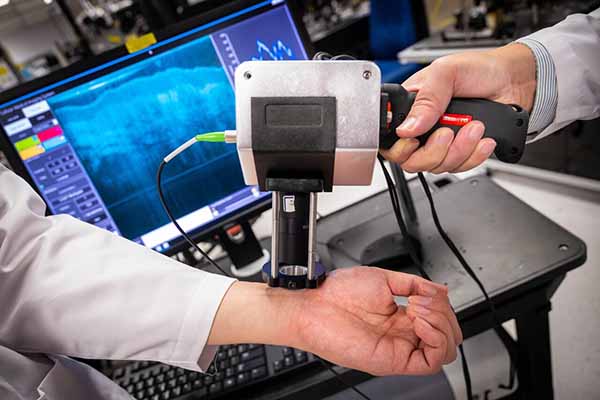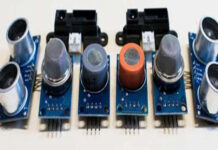High Battery-capacity X-ray Systems Cater to Dental Procedures
There is a growing demand for handheld imaging devices (HID) in dentistry and orthopedics. As such, X-ray/fluoroscopic scanners product segment of the HID market is estimated to reach a value of ~US$ 1.2 Bn by the end of 2027. Hence, companies are innovating in advanced X-ray systems that overcome limitations of conventional wall-mount units. For instance, German-based dental products manufacturer KaVo Dental announced the launch of NOMAD Pro 2- a unique handheld X-ray system, which is available for routine dental purposes.
Advanced handheld X-ray systems are gradually becoming mainstream in most dentistry clinics. Companies in the HID market are focusing on the needs of clinicians so that dentists gain reliability through these systems during busy dental office needs and appreciates. They are increasing their efficacy in technologies that enhance the safety and portability of these systems. Companies in the handheld imaging devices market are introducing X-ray systems with high-capacity battery technology.
High Prevalence Rate of Oral Cancer in India Drives Innovation in Handheld Imaging Devices
According to Engineering for Change, an online platform that solves global development problems, suggests that oral cancer is among the top three cancers diagnosed in India. High prevalence of oral cancer in India led companies in the HID market to develop innovative equipment. For instance, Sascan Meditech-a Bengaluru-based optical imaging technology company, revealed that the company’s device OralScan built with multi-modal imaging camera is undergoing clinical trials.
Healthcare companies in the market for HID are tapping opportunities in software and data analytics to improve patient outcomes. Medical device startups are participating in innovation trade fairs to bolster their credibility credentials in the global HID market. They are augmenting the advantages of cloud to help circulate the captured data among clinicians. Machine learning is also gaining prominence in the global market landscape, since algorithms provide feed on ratio values to assess differences between the types of cancer in patients.
Researchers Develop Handheld Portable Scanners Whole-brain MRI
There is a growing demand for lightweight and portable scanners that perform whole-brain MRI scan for patients with mobility challenges in the HID market. For instance, researchers at the Massachusetts Institute of Technology, Cambridge, developed a cost-effective portable helmet-like scanner that offers promising abilities than conventional MRI systems.
Optical imaging devices product segment of the HID market is projected to reach a value of ~US$ 800 Mn by 2027. Hence, companies in the market for HID are exploring opportunities in optical imaging devices to cater to specific needs of patients.
Innovations in these devices are likely to offer diagnostic-quality images that improve patient quality of life. However, challenges in imaging artefacts during the development of uniform magnetic field for image coding poses as restraint for researchers and manufacturers. Hence, companies in the market for HID should collaborate with researchers to use more flexible image coding approach to generate images with fewer artefacts.
Intelligent Devices Steer Innovation in Dermatology
Clinicians operating in the field of dermatology are eyeing alternatives that offer cost-efficiency and enhance the workflow at clinics. With the introduction of new HID, dermatologists are increasingly relying on smarter ways to perform skin examinations. For instance, Barco, a Belgian technology company specializing in digital image projection is increasing awareness about its product Demetra that provides intelligent and augmented insights.
Innovations in handheld imaging devices are serving as affordable and accessible solutions in skin lesion screening. As such, dermatology application segment of the HID market is anticipated to reach a value of US$ 600 Mn by 2027. Hence, companies are gaining expertise in multispectral digital imaging technology to improve efficiency in skin examinations.
The uptake of handheld imaging devices in dermatology is soaring, since dermatologists chart lesions on mannequins or through clinical overview photographs. Thus, companies in the HID market are helping dermatologists to boost their professional credibility by increasing the availability of technologically sound devices.
- Handheld imaging devices can be defined as mobile or portable imaging devices or scanners utilized to visualize internal organs, or scan body parts, for diagnosis of different diseases and to determine further treatment
- These HID are easy to carry, convenient to handle, and have been gaining popularity for screening various diseases in the last few years
- These handheld imaging devices are majorly used by clinics and provide real-time imaging that is utilized in diverse fields such as urology, dentistry, gynecology, orthopedics, cardiology
- Handheld imaging devices are coupled with apps and software, which can be accessed through smartphones, and physicians can monitor patient’s health indicators by these devices through scanning different body internal organs in real-time
- Increase in incidence of chronic diseases along with a rise in geriatric population is a major factor boosting the global HID market, as these handheld imaging devices are used for early diagnosis of chronic diseases with ease.
- Ongoing developments by major companies in imaging technologies for HID are leading to the introduction of advanced imaging equipment in order to remain competitive in the healthcare services market. Therefore, technological advancements in terms of portability, apps, and software mainly in HID are also fueling the growth of global HID market.
- Rise in number of approved HID by different regulatory authorities across the world is driving the global HID market.
- Surge in inclination toward point of care diagnostic tools is a major factor propelling the global HID market
Market Segmentation: Handheld Imaging Devices Market
- Based on product, the global handheld imaging devices market has been divided into X-ray/fluoroscopy scanners, optical imaging devices, ultrasound scanners, near infrared (NIR) spectroscopy scanners, and optical coherence tomography (OCT) scanners
- In terms of component, the global handheld imaging devices market has been segmented into devices, apps & software, and accessories
- Based on application, the global market has been classified into ophthalmology, endocrinology, urology, gynecology & obstetrics, dermatology, dentistry, cardiology and vascular, orthopedics, and others
- Based on end-user, the global HID market has been segregated into hospitals, diagnostic imaging centers, specialty clinics, and others
- Each of the segments has been analyzed in detail for market trends, recent trends, and developments, drivers, restraints, opportunities, and useful insights.
- The global HID market report provides current and future revenues (US$ Mn) for each these segments for the period from 2017 to 2027, considering 2018 as the base year. The compound annual growth rate (% CAGR) has been provided for each segment and market from 2019 to 2027 along with market size estimations.
Regional Overview: Handheld Imaging Devices Market
- In terms of region, the global handheld imaging devices market has been divided into North America, Europe, Asia Pacific, Latin America, and Middle East & Africa. The regions have been further divided into major countries and sub-regions.
- The current and future market sizes in terms of revenue (US$ Mn) of these regional HID markets and their major countries have been provided in the report for the period from 2017 to 2027, with their CAGRs for the period from 2019 to 2027.
- The study also offers a list of recommendations, highlights, and useful insights of the global HID market which will help new companies willing to enter the market and existing companies to increase market shares, and help in the decision-making process.
Major Players in Handheld Imaging Devices Market
- The global HID report concludes with the company profiles section that includes key information about the major players in the market
- Key players analyzed in this report include
- GE Healthcare (GE Electric Company)
- Koninklijke Philips N.V.
- Siemens Healthineers
- FUJIFILM Corporation
- Micro C,
- LLC
- Butterfly Network, Inc.
- Clarius Mobile Health
- InfraScan, Inc.
- KaVo Dental
- MolecuLight, Inc.
Source: https://www.transparencymarketresearch.com/handheld-imaging-devices-market.html















